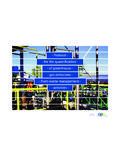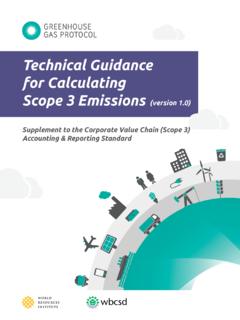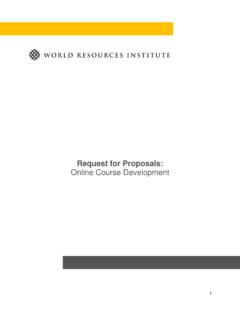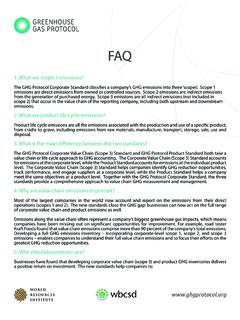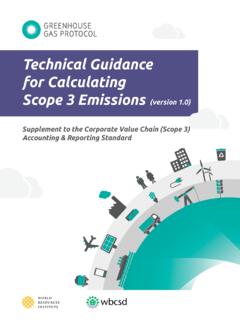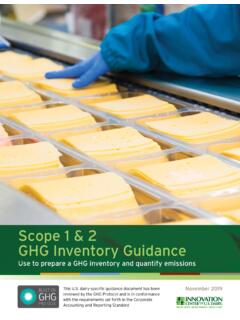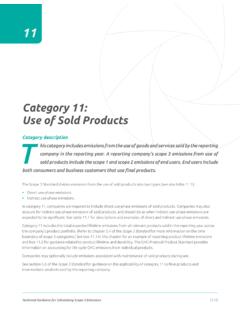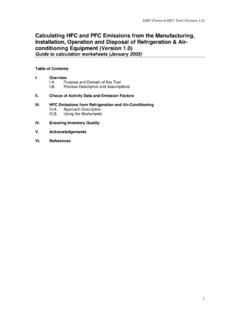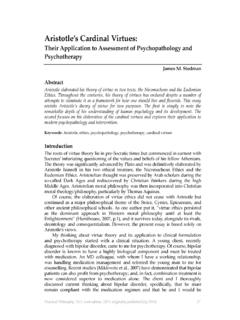Transcription of Corporate Value Chain
1 Corporate Value Chain (Scope 3) Accounting and Reporting StandardSupplement to the GHG Protocol Corporate Accounting and Reporting Standard CO2CH4SF6N2 OHFCsPFCspurchased electricity, steam, heating & cooling for own usepurchased goods and servicescapital goodsfuel and energy related activities transportation and distributionwaste generated in operationsbusiness traveltransportation and distributionprocessing of sold productsuse of sold productsend-of-life treatment of sold productsleased assetsfranchisesemployee commutingleased assetsinvestmentscompany facilitiescompany vehicles[02] Corporate Value Chain (Scope 3) Accounting and Reporting StandardGHG Protocol TeamPankaj Bhatia, World Resources InstituteCynthia Cummis, World Resources InstituteAndrea Brown, World Business Council for Sustainable DevelopmentDavid Rich, World Resources InstituteLaura Draucker, World Resources InstituteHolly Lahd, World Resources InstituteSteering CommitteeGerald Rebitzer, Amcor Topping, Frances Way, Carbon Disclosure Project (CDP)Graham Sinden, The Carbon TrustH.
2 Scott Matthews, Carnegie Mellon UniversityLuc Larmuseau, DNV Climate Change ServicesDavid A. Russell, Rob Rouse, The Dow Chemical CompanyJiang Kejun, Energy Research Institute, China s National Development and Reform CommissionAndrew Hutson, Environmental Defense FundSimon Aum nier, Environmental Resources Management Ugo Pretato, Kirana Chomkhamsri, European Commission Joint Research CentreSteven Meyers, General ElectricSergio Galeano, Georgia Pacific, ISO TC207 Technical Advisory Group Gregory A. Norris, Harvard University, New Earth, University of ArkansasKlaus Radunsky, ISO 14067 Working Group Convener Atsushi Inaba, Kogakuin UniversityAlison Watson, New Zealand Ministry of Agriculture and Forestry Susan Cosper, Nick Shufro, PricewaterhouseCoopers LLPR asmus Priess, THEMA1 GmbH, Product Carbon Footprint World Forum Wanda Callahan, Shell James A. Fava, UNEP SETAC Life Cycle Initiative, Five Winds InternationalMatthias Finkbeiner, UNEP SETAC Life Cycle Initiative, Technische Universit t BerlinHenry King, UnileverSusan Wickwire, John Sottong, United States Environmental Protection AgencyMaureen Nowak, United Kingdom Department of Environment, Food, and Rural AffairsJames Stanway, Miranda Ballentine, Walmart Stores Inc.
3 [01]CHAPTER 02 Defining Business Goalsguidanceguidanceguidancerequirement sguidancerequirementsguidancerequirement sguidanceguidanceguidancerequirementsgui danceguidancerequirementsTable of ContentsCHAPTERS1. Introduction 022. Business Goals 103. summary of Steps and Requirements 184. Accounting and Reporting Principles 225. Identifying Scope 3 Emissions 266. Setting the Scope 3 Boundary 587. Collecting Data 648. Allocating Emissions 869. Setting a GHG Reduction Target and Tracking Emissions Over Time 9810. Assurance 11211. Reporting 118 APPENDICES A. Accounting for Emissions from Leased Assets 124B. Uncertainty in Scope 3 Emissions 126C. Data Management Plan 129 Abbreviations 134 Glossary 135 References 142 Recognitions 143guidanceDefining Business Goals02 Introduction01[03]IntroductionEmissions of the anthropogenic greenhouse gases (GHG) that drive climate change and its impacts around the world are growing.
4 According to climate scientists, global carbon dioxide emissions must be cut by as much as 85 percent below 2000 levels by 2050 to limit global mean temperature increase to 2 degrees Celsius above pre-industrial Temperature rise above this level will produce increasingly unpredictable and dangerous impacts for people and ecosystems. As a result, the need to accelerate efforts to reduce anthropogenic GHG emissions is increasingly urgent. Existing government policies will not sufficiently solve the problem. Leadership and innovation from business is vital to making progress. Corporate action in this arena also makes good business sense. By addressing GHG emissions, companies can identify opportunities to bolster their bottom line, reduce risk, and discover competitive advantages. As impacts from climate change become more frequent and prominent, governments are expected to set new policies and provide additional market-based incentives to drive significant reductions in emissions.
5 These new policy and market drivers will direct economic growth on a low-carbon trajectory. Businesses need to start planning for this transition now as they make decisions that will lock in their investments for years to effective Corporate climate change strategy requires a detailed understanding of a company s GHG impact. A Corporate GHG inventory is the tool to provide such an understanding. It allows companies to take into account their emissions-related risks and opportunities and focus company efforts on their greatest GHG impacts. Until recently, companies have focused their attention on emissions from their own operations. But increasingly companies understand the need to also account for GHG emissions along their Value chains and product portfolios to comprehensively manage GHG-related risks and opportunities. Through the development of the GHG Protocol Corporate Value Chain (Scope 3) Accounting and Reporting Standard, the GHG Protocol has responded to the demand for an internationally accepted method to enable GHG management of companies Value chains.
6 Following the release of this standard, the GHG Protocol and its partners will proactively work with industry groups and governments to promote its widespread use along with the entire suite of GHG Protocol standards and tools to enable more effective GHG management worldwide. guidance[04] Corporate Value Chain (Scope 3) Accounting and Reporting The Greenhouse Gas ProtocolThe Greenhouse Gas Protocol (GHG Protocol) is a multi-stakeholder partnership of businesses, non-governmental organizations (NGOs), governments, and others convened by the World Resources Institute (WRI) and the World Business Council for Sustainable Development (WBCSD). Launched in 1998, the mission of the GHG Protocol is to develop internationally accepted greenhouse gas (GHG) accounting and reporting standards and tools, and to promote their adoption in order to achieve a low emissions economy worldwide.
7 The GHG Protocol has produced the following separate but complementary standards, protocols, and guidelines: GHG Protocol Corporate Accounting and Reporting Standard (2004): A standardized methodology for companies to quantify and report their Corporate GHG emissions. Also referred to as the Corporate Standard. GHG Protocol Product Life Cycle Accounting and Reporting Standard (2011): A standardized methodology to quantify and report GHG emissions associated with individual products throughout their life cycle. Also referred to as the Product Standard. GHG Protocol for Project Accounting (2005): A guide for quantifying reductions from GHG-mitigation projects. Also referred to as the Project Protocol. GHG Protocol for the Public Sector (2010): A step-by-step approach to measuring and reporting emissions from public sector organizations, complementary to the Corporate Standard.
8 GHG Protocol Guidelines for Quantifying GHG Reductions from Grid-Connected Electricity Projects (2007): A guide for quantifying reductions in emissions that either generate or reduce the consumption of electricity transmitted over power grids, to be used in conjunction with the Project Protocol. GHG Protocol Land Use, Land-Use Change, and Forestry Guidance for GHG Project Accounting (2006): A guide to quantify and report reductions from land use, land-use change, and forestry, to be used in conjunction with the Project Protocol. Measuring to Manage: A Guide to Designing GHG Accounting and Reporting Programs (2007): A guide for program developers on designing and implementing effective GHG programs based on accepted standards and methodologies. Purpose of this standardThe GHG Protocol Corporate Value Chain (Scope 3) Accounting and Reporting Standard (also referred to as the Scope 3 Standard) provides requirements and guidance for companies and other organizations to prepare and publicly report a GHG emissions inventory that includes indirect emissions resulting from Value Chain activities ( , scope 3 emissions).
9 The primary goal of this standard is to provide a standardized step-by-step approach to help companies understand their full Value Chain emissions impact in order to focus company efforts on the greatest GHG reduction opportunities, leading to more sustainable decisions about companies activities and the products they buy, sell, and produce. The standard was developed with the following objectives in mind: To help companies prepare a true and fair scope 3 GHG inventory in a cost-effective manner, through the use of standardized approaches and principles To help companies develop effective strategies for managing and reducing their scope 3 emissions through an understanding of Value Chain emissions and associated risks and opportunities To support consistent and transparent public reporting of Corporate Value Chain emissions according to a standardized set of reporting requirements Ultimately, this is more than a technical accounting standard.
10 It is intended to be tailored to business realities and to serve multiple business objectives. Companies may find most Value in implementing the standard using a phased approach, with a focus on improving the quality of the GHG inventory over time. Relationship to the GHG Protocol Corporate StandardThe GHG Protocol Scope 3 Standard is a supplement to the GHG Protocol Corporate Accounting and Reporting Standard, Revised Edition (2004) and should be used in conjunction with it. The Corporate Standard first launched in 2001 and revised in 2004 has been widely adopted by businesses, NGOs, and governments around the world as the international standard for developing and reporting a company-wide GHG inventory. [05]CHAPTER 01 IntroductionThe Scope 3 Standard complements and builds upon the Corporate Standard to promote additional completeness and consistency in the way companies account for and report on indirect emissions from Value Chain activities.
